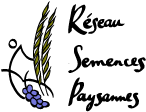Résumé soumis au congrès Eucarpia de novembre 2007
Goldringer Isabelle,
Numerous studies of traditional agricultural systems in the South have shown that the farmers practices for seeds management were the key for local adaptation whilst maintening the genetic diversity, due to the co-exixtence in the populations of all evolutionary mecanisms: selection, genetic drift, migration, mutation (Smith et al., 2001 ; Almekinder et al., 2000 ; Louette et al., 1997 ; Bertaud et al., 2001 ; Elias et al., 2001). Hence, this can be described as a dynamic management approach. In industrialized countries, such approaches are usually developped through the cooperation of farmers and breeders and/or researchers, and they might be of a great interest for organic or low input farming systems where the effects of environment and practices combine to produce a large range of contrasted conditions. Yet, these approaches are scarce and they still do not have found a clear position in the seed regulation framework in France.
To help on farm management or participatory approaches to find an official recognition, there is a need to describe the farmers practices and their effects on genetic diversity, phenotypic differentiation and local adaptation. Here, we present a case study of an old wheat variety (Rouge de Bordeaux, RB) grown for several generations in different farms under different conditions and farming practices. This old variety (a landrace from the 1880s) has rapidly and recently spread over organic farms in France due to its high “artisanale” bread making quality and good adaptation to organic conditions. The origin of the samples grown by the farmers are either the Inra collection of Clermont-Ferrand or other farmers. We are conducting a sociological, historical, ethno-botanical study of the actors, and a parallel genetic study of the varieties/populations in order to assess the ability of this farmers network to conserve and develop genetic diversity through local adaptation and seeds exchanges.
Based on a sociological survey, a partial network of seeds exchange was drawn indicating complex and active exchanges, especially for the variety RB. About 25 different farmers RB varieties were chosen to cover the network and samples were collected as well as 4 samples of RB accessions available at the Inra collection. In 2006-2007, they are being assessed phenotypically in 6 farms and in a research station at Inra (Le Moulon). Leaf samples of 20-35 individuals / RB-sample were collected, DNA was extracted and they will be genotyped using a set of “neutral” SSR markers as well as markers of the VRN1 loci (vernalization response). Within-sample phenotypic and genetic diversity will be studied together with the differentiation between samples at both levels. The first phenotypic data show that the different samples are significantly differentiated with regards to their early development.
À télécharger
-
poster-eucarpianov07-francais.pdf (2,1 Mio)
-
poster-eucarpianov07.ppt (4,8 Mio)
Références complètes
Goldringer Isabelle;1.UMR de Génétique Végétale, INRA Univ. Paris Sud CNRS AgroParisTech, Ferme du Moulon, 91190 Gif sur Yvette, France;2.ENS Paris;3.CNRS - Ehess – Mnhn;4.Réseau Semences Paysannes
